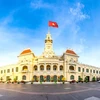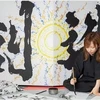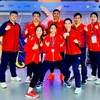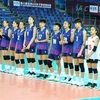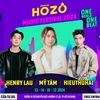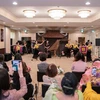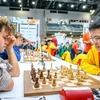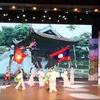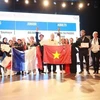 Subordinate to the Vietnam Academy of Social Sciences, the Vietnam Museum of Ethnology is part of the system of Vietnamese national museums. It was formed in the 1980s, when the country was still suffering from extremely difficult socio-economic conditions. The war had just ended a few years before that. On October 24, 1995, the Prime Minister issued a decision to establish the Vietnam Museum of Ethnology. This museum has many different functions. Its curators conduct research, collection, preservation, and restoration of objects and materials of ethnic groups. The museum curators also organise and host exhibitions, performances, and other forms of activities to introduce cultural identities of ethnic groups to people in Vietnam as well as in other countries. (Photo: VietnamPlus)
Subordinate to the Vietnam Academy of Social Sciences, the Vietnam Museum of Ethnology is part of the system of Vietnamese national museums. It was formed in the 1980s, when the country was still suffering from extremely difficult socio-economic conditions. The war had just ended a few years before that. On October 24, 1995, the Prime Minister issued a decision to establish the Vietnam Museum of Ethnology. This museum has many different functions. Its curators conduct research, collection, preservation, and restoration of objects and materials of ethnic groups. The museum curators also organise and host exhibitions, performances, and other forms of activities to introduce cultural identities of ethnic groups to people in Vietnam as well as in other countries. (Photo: VietnamPlus)  Students pose for a group photo at the Vietnam Museum of Ethnology. The museum is located on Nguyen Van Huyen Street in Cau Giay district of Hanoi, about 8km from the centre of the capital city. It is not only one of the must-visit destinations for many visitors to Hanoi but also a famous attraction for local students and residents. On November 12, 1997, on the occasion of a summit of French-speaking nations in Hanoi, it was inaugurated in the presence of Vice President of Vietnam Nguyen Thi Binh and President of the French Republic Jacques Chirac. The museum, covering nearly 4.5 hectares, consists of three exhibition spaces. (Photo: VietnamPlus)
Students pose for a group photo at the Vietnam Museum of Ethnology. The museum is located on Nguyen Van Huyen Street in Cau Giay district of Hanoi, about 8km from the centre of the capital city. It is not only one of the must-visit destinations for many visitors to Hanoi but also a famous attraction for local students and residents. On November 12, 1997, on the occasion of a summit of French-speaking nations in Hanoi, it was inaugurated in the presence of Vice President of Vietnam Nguyen Thi Binh and President of the French Republic Jacques Chirac. The museum, covering nearly 4.5 hectares, consists of three exhibition spaces. (Photo: VietnamPlus)  Students pose for a group photo at the Vietnam Museum of Ethnology. The museum is located on Nguyen Van Huyen Street in Cau Giay district of Hanoi, about 8km from the centre of the capital city. It is not only one of the must-visit destinations for many visitors to Hanoi but also a famous attraction for local students and residents. On November 12, 1997, on the occasion of a summit of French-speaking nations in Hanoi, it was inaugurated in the presence of Vice President of Vietnam Nguyen Thi Binh and President of the French Republic Jacques Chirac. The museum, covering nearly 4.5 hectares, consists of three exhibition spaces. (Photo: VietnamPLus)
Students pose for a group photo at the Vietnam Museum of Ethnology. The museum is located on Nguyen Van Huyen Street in Cau Giay district of Hanoi, about 8km from the centre of the capital city. It is not only one of the must-visit destinations for many visitors to Hanoi but also a famous attraction for local students and residents. On November 12, 1997, on the occasion of a summit of French-speaking nations in Hanoi, it was inaugurated in the presence of Vice President of Vietnam Nguyen Thi Binh and President of the French Republic Jacques Chirac. The museum, covering nearly 4.5 hectares, consists of three exhibition spaces. (Photo: VietnamPLus)  Once setting foot here, visitors will be amazed by unique arrangements in the museum that can help them easily learn cultural identities of different ethnic groups. Vietnam is home to 54 ethnic groups with Kinh people being the majority, accounting for more than 80% of the population. The ethnic groups formed a close-knit community that has stood side by side throughout history to fight against invaders, regain independence and freedom, and build the country. Each ethnic group has its own culture that contributes to the unity in diversity of the Vietnamese culture. Cultural identities of the groups are clearly reflected in their economic activities and tangible and intangible cultural practices. (Photo: VietnamPlus)
Once setting foot here, visitors will be amazed by unique arrangements in the museum that can help them easily learn cultural identities of different ethnic groups. Vietnam is home to 54 ethnic groups with Kinh people being the majority, accounting for more than 80% of the population. The ethnic groups formed a close-knit community that has stood side by side throughout history to fight against invaders, regain independence and freedom, and build the country. Each ethnic group has its own culture that contributes to the unity in diversity of the Vietnamese culture. Cultural identities of the groups are clearly reflected in their economic activities and tangible and intangible cultural practices. (Photo: VietnamPlus)  Among the three exhibition sections of the Vietnam Museum of Ethnology, the Bronze Drum building features two spaces – one for introducing the cultures of 54 ethnic groups on the first floor and the other for thematic exhibitions on the second floor. Designed by Tay ethnic architect Ha Duc Linh, it was modeled after a bronze drum of the renowned Dong Son Civilisation. This two-storey building has a total exhibition area of 2,000 square metres. It was unveiled by then Vice President of Vietnam Nguyen Thi Binh and President of France Jacques Chirac in November 1997, on the occasion of the summit of francophone countries held in Hanoi. (Photo: VietnamPlus)
Among the three exhibition sections of the Vietnam Museum of Ethnology, the Bronze Drum building features two spaces – one for introducing the cultures of 54 ethnic groups on the first floor and the other for thematic exhibitions on the second floor. Designed by Tay ethnic architect Ha Duc Linh, it was modeled after a bronze drum of the renowned Dong Son Civilisation. This two-storey building has a total exhibition area of 2,000 square metres. It was unveiled by then Vice President of Vietnam Nguyen Thi Binh and President of France Jacques Chirac in November 1997, on the occasion of the summit of francophone countries held in Hanoi. (Photo: VietnamPlus)  Most of the space of the Bronze Drum building is zoned for permanently exhibiting the cultures of the 54 ethnic groups. It displays about 15,000 items along with 42,000 video clips and photos depicting the daily life activities, costumes, farming tools, religions, beliefs, and customs of ethnic communities. Visitors can also learn more about ethnic cultures through a number of writings by the museum’s researchers on display here. This exhibition space was made in coordination with the French Government, ethnologist Christine Hemmet, architect Véronique Dollfus, museologists from the Paris-based Museum of Mankind, and French exhibition designers. All information is shown in three languages - Vietnamese, French, and English. (Photo: VietnamPlus)
Most of the space of the Bronze Drum building is zoned for permanently exhibiting the cultures of the 54 ethnic groups. It displays about 15,000 items along with 42,000 video clips and photos depicting the daily life activities, costumes, farming tools, religions, beliefs, and customs of ethnic communities. Visitors can also learn more about ethnic cultures through a number of writings by the museum’s researchers on display here. This exhibition space was made in coordination with the French Government, ethnologist Christine Hemmet, architect Véronique Dollfus, museologists from the Paris-based Museum of Mankind, and French exhibition designers. All information is shown in three languages - Vietnamese, French, and English. (Photo: VietnamPlus)  The Vietnam Museum of Ethnology keeps and showcases a large number of objects, as well as video clips and audio files of interviews and music related to the 54 ethnic groups in the country. The exhibits are classified according to different criteria such as ethnic groups, tools, costumes, jewellery, farming tools, fishing gears, weapons, household utensils, musical instruments, religion - belief, wedding and funeral rituals, and other spiritual and social activities. All information used in exhibition, including writings and notes, is shown in Vietnamese, English, and French. Besides, the museum has also produced many leaflets containing main information in other languages like Chinese, German, and Japanese which are distributed to visitors free of charge. (Photo: VietnamPlus)
The Vietnam Museum of Ethnology keeps and showcases a large number of objects, as well as video clips and audio files of interviews and music related to the 54 ethnic groups in the country. The exhibits are classified according to different criteria such as ethnic groups, tools, costumes, jewellery, farming tools, fishing gears, weapons, household utensils, musical instruments, religion - belief, wedding and funeral rituals, and other spiritual and social activities. All information used in exhibition, including writings and notes, is shown in Vietnamese, English, and French. Besides, the museum has also produced many leaflets containing main information in other languages like Chinese, German, and Japanese which are distributed to visitors free of charge. (Photo: VietnamPlus)  Visitors can learn about ethnic groups of Vietnam through a wide range of objects, video clips, photos, and writings by researchers shown at the museum. Among the 54 ethnic groups, Kinh people make up about 86% of the population and the remainders are ethnic minorities. Languages of ethnic groups in Vietnam belong to five language families: Austroasiatic languages (including Viet-Muong and Mon-Khmer), Thai-Kadai languages (including Tay-Thai and Kadai), Mong-Dao languages, Sino-Tibetan languages (including Tibetan-Burmese and Chinese), and Austronesian languages. Ethnic groups have their own cultural identities, but they also share certain similarities. Their cultures were formed on the basis of their groups’ traditions as well as the confluence with other cultures. (Photo: VietnamPlus)
Visitors can learn about ethnic groups of Vietnam through a wide range of objects, video clips, photos, and writings by researchers shown at the museum. Among the 54 ethnic groups, Kinh people make up about 86% of the population and the remainders are ethnic minorities. Languages of ethnic groups in Vietnam belong to five language families: Austroasiatic languages (including Viet-Muong and Mon-Khmer), Thai-Kadai languages (including Tay-Thai and Kadai), Mong-Dao languages, Sino-Tibetan languages (including Tibetan-Burmese and Chinese), and Austronesian languages. Ethnic groups have their own cultural identities, but they also share certain similarities. Their cultures were formed on the basis of their groups’ traditions as well as the confluence with other cultures. (Photo: VietnamPlus)  A ritual pole called “xang booc” of Thai people on display at the Bronze Drum building. This object is the centre of a ceremony held to celebrate the bamboo sprouting season and pay tribute to gods. After this worshipping ceremony, Thai people traditionally sing and dance around the ritual pole. Thai people form the third most populous ethnic groups in Vietnam, after Kinh and Tay. They have resided in the northwestern region of the country for more than 1,200 years, mostly in Lai Chau, Dien Bien, Lao Cai, Yen Bai, Son La, Hoa Binh, Thanh Hoa, and Nghe An. This group includes several branches such as Tay Don (White Thai), Tay Dam (Black Thai), and Tay Deng (Red Thai). (Photo: VietnamPlus)
A ritual pole called “xang booc” of Thai people on display at the Bronze Drum building. This object is the centre of a ceremony held to celebrate the bamboo sprouting season and pay tribute to gods. After this worshipping ceremony, Thai people traditionally sing and dance around the ritual pole. Thai people form the third most populous ethnic groups in Vietnam, after Kinh and Tay. They have resided in the northwestern region of the country for more than 1,200 years, mostly in Lai Chau, Dien Bien, Lao Cai, Yen Bai, Son La, Hoa Binh, Thanh Hoa, and Nghe An. This group includes several branches such as Tay Don (White Thai), Tay Dam (Black Thai), and Tay Deng (Red Thai). (Photo: VietnamPlus)  Visitors to the Vietnam Museum of Ethnology can appreciate the carefully and beautifully displayed objects, from costumes and work tools to models of ritual, funeral, and wedding practices. All of these items are vivid demonstrations of the daily life as well as traditional cultures of ethnic groups. There are many items used in daily activities, especially traditionally made clothes like loincloths, skirts, and scarves. There are also natural fibre woven items such as bamboo back baskets, containers, and food trays, bamboo and gourd musical instruments and ritual objects. In addition, photos and documentaries shown at the museum also reflect outstanding tangible and intangible cultural aspects of ethnic groups. (Photo: VietnamPlus)
Visitors to the Vietnam Museum of Ethnology can appreciate the carefully and beautifully displayed objects, from costumes and work tools to models of ritual, funeral, and wedding practices. All of these items are vivid demonstrations of the daily life as well as traditional cultures of ethnic groups. There are many items used in daily activities, especially traditionally made clothes like loincloths, skirts, and scarves. There are also natural fibre woven items such as bamboo back baskets, containers, and food trays, bamboo and gourd musical instruments and ritual objects. In addition, photos and documentaries shown at the museum also reflect outstanding tangible and intangible cultural aspects of ethnic groups. (Photo: VietnamPlus)  The museum is open from 8:30am to 5:30pm from Tuesday to Sunday, and closed on Monday and the Lunar New Year holiday. Admission charges are 40,000 VND per adult, 15,000 VND for higher education students each, and 10,000 for those aged 6 - 18. Ticket prices are halved for ethnic minority people and beneficiaries of preferential policies on cultural enjoyment, including the elderly and people with disabilities. Meanwhile, free admission is applied to children under six years old, persons with particularly severe disabilities, holders of the “Friends of the Vietnam Museum of Ethnology” card, journalists, and donors. Vietnamese and French/English language tour guides are also available here. (Photo: VietnamPlus)
The museum is open from 8:30am to 5:30pm from Tuesday to Sunday, and closed on Monday and the Lunar New Year holiday. Admission charges are 40,000 VND per adult, 15,000 VND for higher education students each, and 10,000 for those aged 6 - 18. Ticket prices are halved for ethnic minority people and beneficiaries of preferential policies on cultural enjoyment, including the elderly and people with disabilities. Meanwhile, free admission is applied to children under six years old, persons with particularly severe disabilities, holders of the “Friends of the Vietnam Museum of Ethnology” card, journalists, and donors. Vietnamese and French/English language tour guides are also available here. (Photo: VietnamPlus)  Visitors will be attracted by vivid exhibits demonstrating the life of ethnic groups across the country. All the 54 ethnic groups in Vietnam are introduced through 12 continuous spaces in the permanent exhibition section of the Bronze Drum building, namely overall introduction; Viet; Muong, Tho, Chut; Tay - Thai, Kadai, Mong - Dao, Tibetan - Burmese; Mon - Khmer in the north; Mon - Khmer in the Truong Son - Tay Nguyen (Central Highlands) region; Astronesian; Cham, Hoa, Khmer; and cultural exchange. Thanks to permanent and temporary displays, frequent demonstrations of intangible cultural heritage, and educational activities, among others, the Vietnam Museum of Ethnology has become an attractive destination for both domestic and foreign visitors. (Photo: VietnamPlus)
Visitors will be attracted by vivid exhibits demonstrating the life of ethnic groups across the country. All the 54 ethnic groups in Vietnam are introduced through 12 continuous spaces in the permanent exhibition section of the Bronze Drum building, namely overall introduction; Viet; Muong, Tho, Chut; Tay - Thai, Kadai, Mong - Dao, Tibetan - Burmese; Mon - Khmer in the north; Mon - Khmer in the Truong Son - Tay Nguyen (Central Highlands) region; Astronesian; Cham, Hoa, Khmer; and cultural exchange. Thanks to permanent and temporary displays, frequent demonstrations of intangible cultural heritage, and educational activities, among others, the Vietnam Museum of Ethnology has become an attractive destination for both domestic and foreign visitors. (Photo: VietnamPlus)  From left: Back baskets of the ethnic minorities of Ma (Lam Dong province), Mnong (Dak Lak province), Bana (Kon Tum province), Brau (Kon Tum), Gie Trieng (Kon Tum), and Ta Oi (Thua Thien – Hue). Some crossbows and spears are also on display. In the past, most of the ethnic communities in Vietnam earned their living by cultivating wet rice or hill rice, farming poultry and livestock, hunting, gathering fruit, and doing traditional crafts such as fabric weaving, blacksmithing, pottery making, and carpentry. Villages form an important unit in the structures of all ethnic groups’ societies. However, their house styles, family and social traditions, religions, and beliefs are highly diverse. (Photo: VietnamPlus)
From left: Back baskets of the ethnic minorities of Ma (Lam Dong province), Mnong (Dak Lak province), Bana (Kon Tum province), Brau (Kon Tum), Gie Trieng (Kon Tum), and Ta Oi (Thua Thien – Hue). Some crossbows and spears are also on display. In the past, most of the ethnic communities in Vietnam earned their living by cultivating wet rice or hill rice, farming poultry and livestock, hunting, gathering fruit, and doing traditional crafts such as fabric weaving, blacksmithing, pottery making, and carpentry. Villages form an important unit in the structures of all ethnic groups’ societies. However, their house styles, family and social traditions, religions, and beliefs are highly diverse. (Photo: VietnamPlus)  These are some ancient books and a book made of leaves of the Tay and Thai ethnic groups in Thai Nguyen and Son La provinces. Tay people, also called Tho, have a population of more than 1.8 million, forming the second largest ethnic group in Vietnam after Kinh. Their language belongs to the Thai - Kadai language family. They mainly reside in northern provinces such as Cao Bang, Bac Kan, Thai Nguyen, Tuyen Quang, Ha Giang, and Quang Ninh. Tay people were first present in Vietnam in the latter half of the first millennium BC. At present, ethnic groups in Vietnam are at different levels of development. (Photo: VietnamPlus)
These are some ancient books and a book made of leaves of the Tay and Thai ethnic groups in Thai Nguyen and Son La provinces. Tay people, also called Tho, have a population of more than 1.8 million, forming the second largest ethnic group in Vietnam after Kinh. Their language belongs to the Thai - Kadai language family. They mainly reside in northern provinces such as Cao Bang, Bac Kan, Thai Nguyen, Tuyen Quang, Ha Giang, and Quang Ninh. Tay people were first present in Vietnam in the latter half of the first millennium BC. At present, ethnic groups in Vietnam are at different levels of development. (Photo: VietnamPlus)  Hand-made skirts on display at the area for showing the cultures of Red Dao, Black Thai, and White Thai people. For three years in a row – 2012, 2013 and 2014, the Vietnam Museum of Ethnology was selected as one of the best museums by famous travel website TripAdvisor. From 2015 to 2017, it was also honoured as the top tourist destination in Vietnam by the Ministry of Culture, Sports and Tourism, the Vietnam National Administration of Tourism, and the Vietnam Tourism Association. Amid the COVID-19 pandemic, it has stayed creative to offer the public diverse and special cultural products adapted to changes in demand as well as the “new normal” status. (Photo: VietnamPlus)
Hand-made skirts on display at the area for showing the cultures of Red Dao, Black Thai, and White Thai people. For three years in a row – 2012, 2013 and 2014, the Vietnam Museum of Ethnology was selected as one of the best museums by famous travel website TripAdvisor. From 2015 to 2017, it was also honoured as the top tourist destination in Vietnam by the Ministry of Culture, Sports and Tourism, the Vietnam National Administration of Tourism, and the Vietnam Tourism Association. Amid the COVID-19 pandemic, it has stayed creative to offer the public diverse and special cultural products adapted to changes in demand as well as the “new normal” status. (Photo: VietnamPlus)  A demonstration of the “cap sac” (coming-of-age) ceremony of Red Dao people in the northern mountainous province of Yen Bai. This ceremony marks the maturity of Dao men. The Dao ethnic group, also called Man, has a population of over 890,000 and includes many branches such as Dao Do (Red Dao), Dao Quan chet, Dao Lo gang, Dao Tien, Dao Quan trang, Dao Thanh y, and Dao Lan Ten. They originated in China and migrated to Vietnam from the 12th century to the first half of the 20th century. Their living area has spread from Vietnam - China and Vietnam - Laos border areas to some midland and coastal provinces in the northern region. (Photo: VietnamPlus)
A demonstration of the “cap sac” (coming-of-age) ceremony of Red Dao people in the northern mountainous province of Yen Bai. This ceremony marks the maturity of Dao men. The Dao ethnic group, also called Man, has a population of over 890,000 and includes many branches such as Dao Do (Red Dao), Dao Quan chet, Dao Lo gang, Dao Tien, Dao Quan trang, Dao Thanh y, and Dao Lan Ten. They originated in China and migrated to Vietnam from the 12th century to the first half of the 20th century. Their living area has spread from Vietnam - China and Vietnam - Laos border areas to some midland and coastal provinces in the northern region. (Photo: VietnamPlus)  Some pieces of jewellery like bracelets and earrings of different ethnic groups are showcased. The Vietnam Museum of Ethnology was also the only museum in the country to be granted a certificate of merit by the Ministry of Culture, Sports and Tourism for its outstanding achievements in designing and organising tourism activities in 2021. To obtain such national and international recognition, apart from efforts by its staff, the museum has also received effective assistance from many experts, along with domestic and international organisations. Since it was opened to the public on November 12, 1997, the museum has welcomed about 500,000 visitors each year, including roughly 14,000 on the annual Mid-Autumn Festival occasion. (Photo: VietnamPlus)
Some pieces of jewellery like bracelets and earrings of different ethnic groups are showcased. The Vietnam Museum of Ethnology was also the only museum in the country to be granted a certificate of merit by the Ministry of Culture, Sports and Tourism for its outstanding achievements in designing and organising tourism activities in 2021. To obtain such national and international recognition, apart from efforts by its staff, the museum has also received effective assistance from many experts, along with domestic and international organisations. Since it was opened to the public on November 12, 1997, the museum has welcomed about 500,000 visitors each year, including roughly 14,000 on the annual Mid-Autumn Festival occasion. (Photo: VietnamPlus)  Next to the Bronze Drum building is the Kite building with a modern design, which is designated to introduce the cultures of Southeast Asian countries. The four-storey building, housing the first exhibition in late 2013, was designed by architects from the Hanoi University of Civil Engineering. Its design was modelled after a kite – part of the traditional culture of not only Vietnam but also other countries in Southeast Asia. This building accommodates four permanent exhibitions which are about the Southeast Asian cultures, glass paintings of Indonesia, some cultures in Asia, and those around the world. Besides, there are also spaces for temporary displays, educational activities, a convention hall, a film screening room, and a multimedia room. (Photo: VietnamPlus)
Next to the Bronze Drum building is the Kite building with a modern design, which is designated to introduce the cultures of Southeast Asian countries. The four-storey building, housing the first exhibition in late 2013, was designed by architects from the Hanoi University of Civil Engineering. Its design was modelled after a kite – part of the traditional culture of not only Vietnam but also other countries in Southeast Asia. This building accommodates four permanent exhibitions which are about the Southeast Asian cultures, glass paintings of Indonesia, some cultures in Asia, and those around the world. Besides, there are also spaces for temporary displays, educational activities, a convention hall, a film screening room, and a multimedia room. (Photo: VietnamPlus)  Visitors at the Kite building. The Vietnam Museum of Ethnology has organised many programmes for students to connect its activities with school curricula. These include designing tours for students of each educational level – primary, junior high school senior high school, and higher education. They provide information materials for students and teachers according to educational levels. There are training courses for teachers, and programmes for education in local cultural heritage placed into school curricula. In addition, it has also held thematic talks and exhibitions outside the museum, along with other activities at the request of schools. Through such activities, the museum has also established itself as a partner of schools, students, teachers in teaching and learning. (Photo: VietnamPlus)
Visitors at the Kite building. The Vietnam Museum of Ethnology has organised many programmes for students to connect its activities with school curricula. These include designing tours for students of each educational level – primary, junior high school senior high school, and higher education. They provide information materials for students and teachers according to educational levels. There are training courses for teachers, and programmes for education in local cultural heritage placed into school curricula. In addition, it has also held thematic talks and exhibitions outside the museum, along with other activities at the request of schools. Through such activities, the museum has also established itself as a partner of schools, students, teachers in teaching and learning. (Photo: VietnamPlus)  In this modern-style space, the museum not only showcases cultural heritage of many countries for visitors to explore, but it is also a bridge linking people from far and wide. The exhibition of Southeast Asian cultures is a result of the long-term cooperation between the Vietnam Museum of Ethnology and many other museums and cultural agencies of regional countries. The construction of the Kite building is said to have marked a new step of the museum’s development. It has contributed to the multiplicity of the museum, including conducting scientific studies, collecting, preserving, displaying, and holding educational activities to help preserve cultural diversity of ethnic groups in Vietnam, as well as Southeast Asia and the world at large. (Photo: VietnamPlus)
In this modern-style space, the museum not only showcases cultural heritage of many countries for visitors to explore, but it is also a bridge linking people from far and wide. The exhibition of Southeast Asian cultures is a result of the long-term cooperation between the Vietnam Museum of Ethnology and many other museums and cultural agencies of regional countries. The construction of the Kite building is said to have marked a new step of the museum’s development. It has contributed to the multiplicity of the museum, including conducting scientific studies, collecting, preserving, displaying, and holding educational activities to help preserve cultural diversity of ethnic groups in Vietnam, as well as Southeast Asia and the world at large. (Photo: VietnamPlus)  Clothing pieces of Indonesian and Malaysian peoples. Administratively, Southeast Asia consists of eleven countries: Thailand, Myanmar, Laos, Cambodia, Vietnam, Singapore, Indonesia, Malaysia, Brunei, the Philippines, and Timor-Leste. Southeast Asia has a combined population of more than 600 million. However, from an ethnological perspective, this region also covers the south of China and part of the northeast of India. Living in a tropical monsoon region, Southeast Asian inhabitants have created unique and diverse cultures. Across the region, people have been living on rice and practicing wet or hill rice cultivation. They also own a wide range of folk arts. They follow diverse religions, from Hinduism, Buddhism, Islam to Catholicism, which have developed based on local beliefs. (Photo: VietnamPlus)
Clothing pieces of Indonesian and Malaysian peoples. Administratively, Southeast Asia consists of eleven countries: Thailand, Myanmar, Laos, Cambodia, Vietnam, Singapore, Indonesia, Malaysia, Brunei, the Philippines, and Timor-Leste. Southeast Asia has a combined population of more than 600 million. However, from an ethnological perspective, this region also covers the south of China and part of the northeast of India. Living in a tropical monsoon region, Southeast Asian inhabitants have created unique and diverse cultures. Across the region, people have been living on rice and practicing wet or hill rice cultivation. They also own a wide range of folk arts. They follow diverse religions, from Hinduism, Buddhism, Islam to Catholicism, which have developed based on local beliefs. (Photo: VietnamPlus)  The Architectural Garden section is another must-visit part of the Vietnam Museum of Ethnology. The outdoor exhibition space features greenery, an artificial spring that flows to a pool where water puppetry is performed. The space also has small paths leading visitors to 10 folk architectural structures in Vietnam: houses of Cham, Viet (Kinh), Bana, Ede, Tay, Dao, Mong, and Ha Nhi people, along with tomb houses of Giarai and Cotu ethnic groups. Together with the permanent exhibition at the Bronze Drum building, this space also helps highlight cultural diversity of ethnic communities across the country. The museum has a total area of almost 43,800 square metres, of which 20,000 square metres is covered by the Architectural Garden. (Photo: VietnamPlus)
The Architectural Garden section is another must-visit part of the Vietnam Museum of Ethnology. The outdoor exhibition space features greenery, an artificial spring that flows to a pool where water puppetry is performed. The space also has small paths leading visitors to 10 folk architectural structures in Vietnam: houses of Cham, Viet (Kinh), Bana, Ede, Tay, Dao, Mong, and Ha Nhi people, along with tomb houses of Giarai and Cotu ethnic groups. Together with the permanent exhibition at the Bronze Drum building, this space also helps highlight cultural diversity of ethnic communities across the country. The museum has a total area of almost 43,800 square metres, of which 20,000 square metres is covered by the Architectural Garden. (Photo: VietnamPlus)  “Nha rong” (communal house) is a unique architectural structure used for community activities of Bana ethnic people. It also serves as a shelter from natural disasters and wild animals. The house displayed at the museum is 19 meters in height, including 3-meter stilts. Its floor area is more than 90 square meters. It was built by 40 Bana people from Kon Rbang village of Kon Tum city, the Central Highlands province of Kon Tum. It was modeled after the village's communal house in the early 20th century. The high roof is supported by eight massive pillars, four of which are 60cm in diameter. The structure is composed of many other posts and beams arranged horizontally, vertically or diagonally. (Photo: VietnamPlus)
“Nha rong” (communal house) is a unique architectural structure used for community activities of Bana ethnic people. It also serves as a shelter from natural disasters and wild animals. The house displayed at the museum is 19 meters in height, including 3-meter stilts. Its floor area is more than 90 square meters. It was built by 40 Bana people from Kon Rbang village of Kon Tum city, the Central Highlands province of Kon Tum. It was modeled after the village's communal house in the early 20th century. The high roof is supported by eight massive pillars, four of which are 60cm in diameter. The structure is composed of many other posts and beams arranged horizontally, vertically or diagonally. (Photo: VietnamPlus)  The stage for water puppetry is located in the Architectural Garden. Performances are often held on the weekend. Water puppetry is a tradition that dates back as far as the 11th century when it originated in villages of the Red River Delta of northern Vietnam. Today's Vietnamese water puppetry is a unique variation on the ancient Asian puppet tradition. The puppets are made out of wood and then lacquered. The shows are performed in a waist-deep pool. A large bamboo rod supports the puppets under the water and is used by puppeteers to control them. The puppeteers are normally hidden behind a screen. Thus, the puppets appear to be moving over the water. (Photo: VietnamPlus)
The stage for water puppetry is located in the Architectural Garden. Performances are often held on the weekend. Water puppetry is a tradition that dates back as far as the 11th century when it originated in villages of the Red River Delta of northern Vietnam. Today's Vietnamese water puppetry is a unique variation on the ancient Asian puppet tradition. The puppets are made out of wood and then lacquered. The shows are performed in a waist-deep pool. A large bamboo rod supports the puppets under the water and is used by puppeteers to control them. The puppeteers are normally hidden behind a screen. Thus, the puppets appear to be moving over the water. (Photo: VietnamPlus)  Visitors to the Vietnam Museum of Ethnology. The museum is located on a street named Nguyen Van Huyen, who served as the Minister of Education of Vietnam from 1946 to 1975. Huyen (1905 - 1975) was a professor, historian, educator, ethnologist, and researcher of the Vietnamese culture. The museum performs many functions, including the support of research, collection, preservation, and restoration of objects and materials of ethnic groups. It also plays host to organising exhibitions, performances, and other forms of activities to introduce cultural identities of ethnic groups to visitors from far and wide. Displaying long-standing cultural values of the 54 ethnic groups in Vietnam and those of other countries, the museum is a not-to-be-missed destination for visitors once they set foot in Hanoi. (Photo: VietnamPlus)
Visitors to the Vietnam Museum of Ethnology. The museum is located on a street named Nguyen Van Huyen, who served as the Minister of Education of Vietnam from 1946 to 1975. Huyen (1905 - 1975) was a professor, historian, educator, ethnologist, and researcher of the Vietnamese culture. The museum performs many functions, including the support of research, collection, preservation, and restoration of objects and materials of ethnic groups. It also plays host to organising exhibitions, performances, and other forms of activities to introduce cultural identities of ethnic groups to visitors from far and wide. Displaying long-standing cultural values of the 54 ethnic groups in Vietnam and those of other countries, the museum is a not-to-be-missed destination for visitors once they set foot in Hanoi. (Photo: VietnamPlus) VNA


